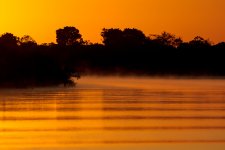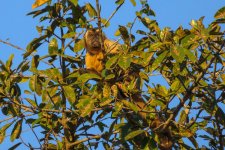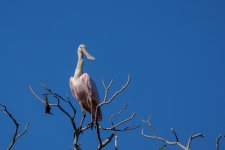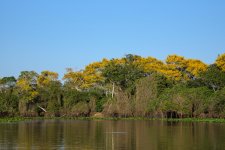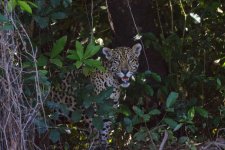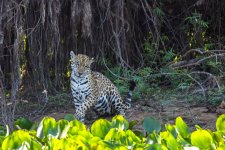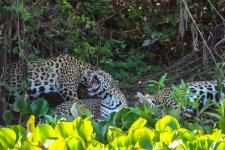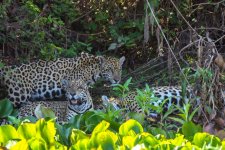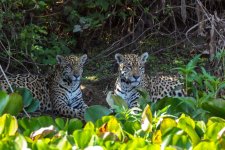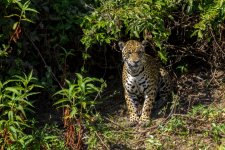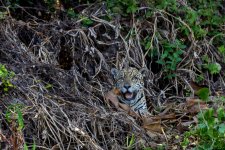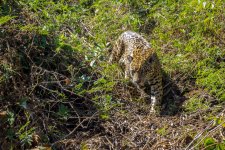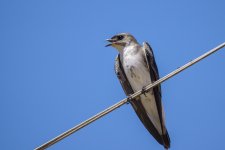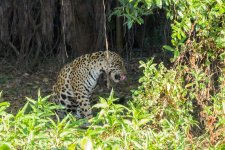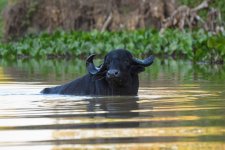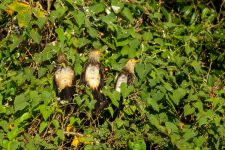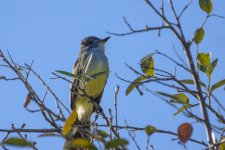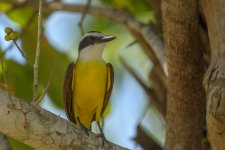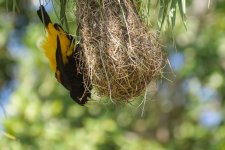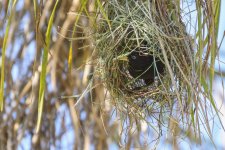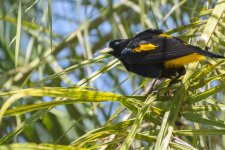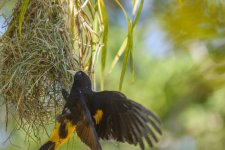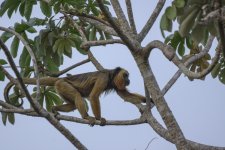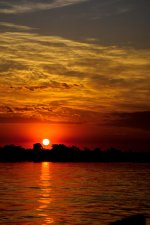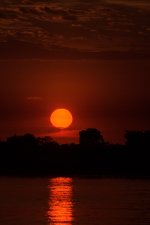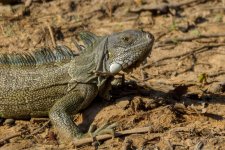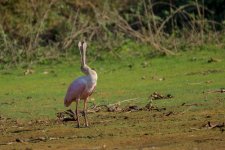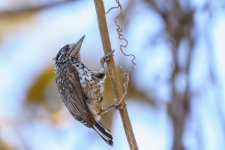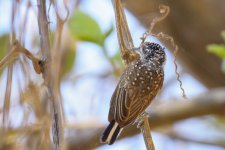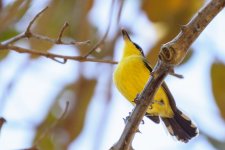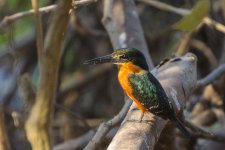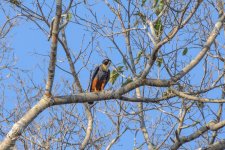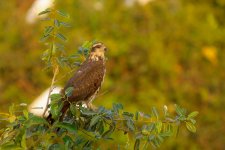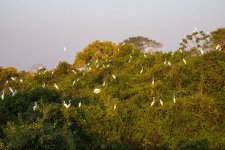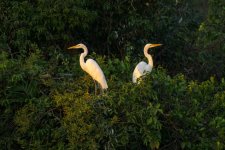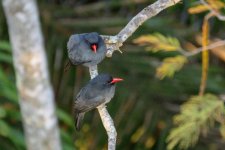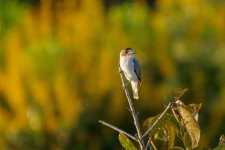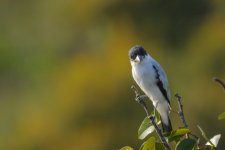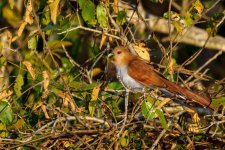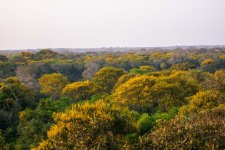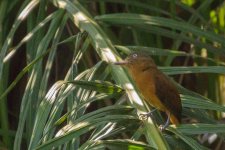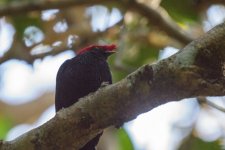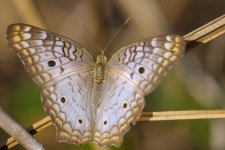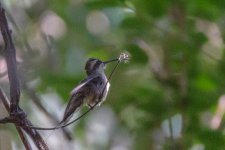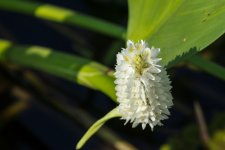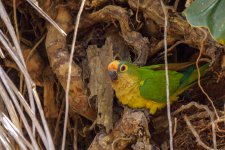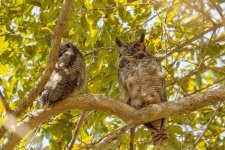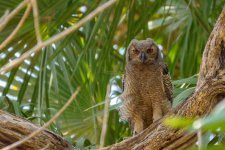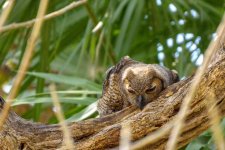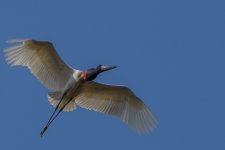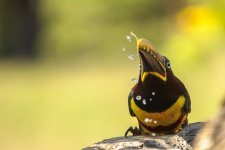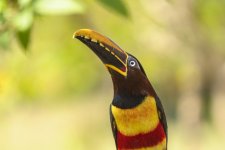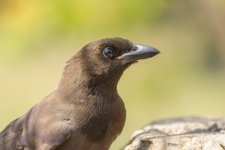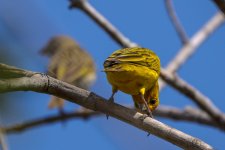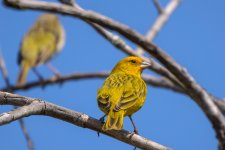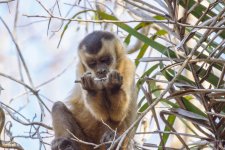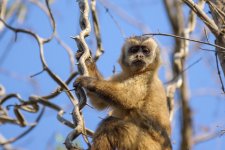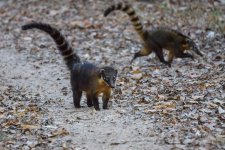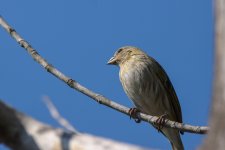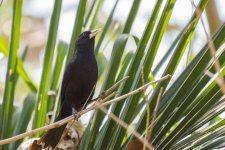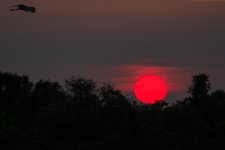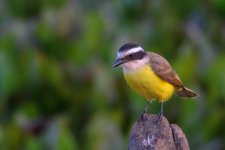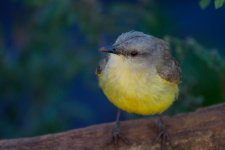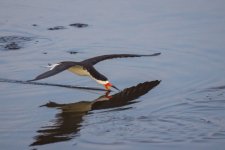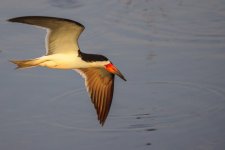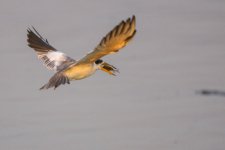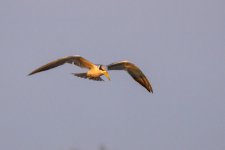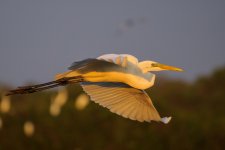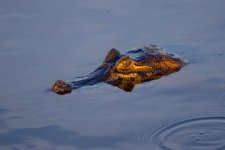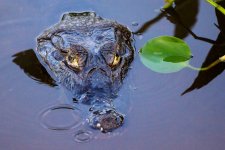-
Welcome to BirdForum, the internet's largest birding community with thousands of members from all over the world. The forums are dedicated to wild birds, birding, binoculars and equipment and all that goes with it.
Please register for an account to take part in the discussions in the forum, post your pictures in the gallery and more.
You are using an out of date browser. It may not display this or other websites correctly.
You should upgrade or use an alternative browser.
You should upgrade or use an alternative browser.
Brazil - the Pantanal and a bit of Atlantic rain forest (1 Viewer)
- Thread starter kitefarrago
- Start date
More options
Who Replied?kitefarrago
Well-known member
The next morning we leave again just as the sky turns from black go grey. This time we travel up the Cuaiaba river,a nd then go up a smaller tributary once again. It's amazing how many of the larger water-dependent birds, mostly herons and storks, there are hear. The eating must be good!
We get our first decent look at Black Howler Monkeys, one near the top of a tree, and another that's reasonably well visible. The birds are starting to wake up, the egrets fly from their roosts - presumably the Cattle Egrets are looking for some open grassland to feed on, while the others will stay on the river.
Octavio tries playback occasionally to get a bird to show itself rather than remain in the undergrowth, but today that does not seem to work at all. The only new bird of the morning is a Forest Eleania, and we do get a Roseate Spoonbill posing for us.
But then it all gets a bit slow, with not much being sighted, but still - you never know what might be around the next bend. Then Belo, our boat driver, spots a jaguar. It's quite deep into the forest, and I can't see it, although it's clear that both Belo and Octavio can make it out. In fact, there are three of them!
We play hide and seek with them for a few minutes, and frustratingly I still can't see any of them. And then they vanish, and we move on. Not long after we hear that they're back and we return, and I manage to catch glimpses of two of them this time. Then they vanish again.
Early morning on the river
Black Howler Monkey
Roseate Spoonbill
Typical river shore
Peekabo!
Andrea
We get our first decent look at Black Howler Monkeys, one near the top of a tree, and another that's reasonably well visible. The birds are starting to wake up, the egrets fly from their roosts - presumably the Cattle Egrets are looking for some open grassland to feed on, while the others will stay on the river.
Octavio tries playback occasionally to get a bird to show itself rather than remain in the undergrowth, but today that does not seem to work at all. The only new bird of the morning is a Forest Eleania, and we do get a Roseate Spoonbill posing for us.
But then it all gets a bit slow, with not much being sighted, but still - you never know what might be around the next bend. Then Belo, our boat driver, spots a jaguar. It's quite deep into the forest, and I can't see it, although it's clear that both Belo and Octavio can make it out. In fact, there are three of them!
We play hide and seek with them for a few minutes, and frustratingly I still can't see any of them. And then they vanish, and we move on. Not long after we hear that they're back and we return, and I manage to catch glimpses of two of them this time. Then they vanish again.
Early morning on the river
Black Howler Monkey
Roseate Spoonbill
Typical river shore
Peekabo!
Andrea
Attachments
kitefarrago
Well-known member
The other two boats in our little group decide to chase a sighting on the Cuiaba, whereas we continue upstream to go bird watching. For a third time we return to the vicinity of the sighting, and this time we do see all three jaguars reasonably well.
The river is narrow, and fortunately there aren't too many boats here. They all hug the opposite side of the river, but there certainly is a good amount of floating into another boats' sightline, and while our guide is poling the boat along to avoid using the engine, one of his colleagues is rather noisy with his.
Photographically speaking this is a tough assignment, with very brightly lit vegetation in the front, and jaguars in the shade at the back, but who can complain about that when they get to see three jaguars at once?
We have a female with two almost grown young, they're estimated to be around two years old. Then the cubs lying down while the mother moves off. Octavio thinks she's going hunting - having to feed three practically fully grown Jaguars requires a lot of food. Then the two young vanish, but we get to watch their mother patrol the river shore for a while before she becomes invisible.
Youngster
Greeting
There really were three
Waiting
Looking for lunch
Andrea
The river is narrow, and fortunately there aren't too many boats here. They all hug the opposite side of the river, but there certainly is a good amount of floating into another boats' sightline, and while our guide is poling the boat along to avoid using the engine, one of his colleagues is rather noisy with his.
Photographically speaking this is a tough assignment, with very brightly lit vegetation in the front, and jaguars in the shade at the back, but who can complain about that when they get to see three jaguars at once?
We have a female with two almost grown young, they're estimated to be around two years old. Then the cubs lying down while the mother moves off. Octavio thinks she's going hunting - having to feed three practically fully grown Jaguars requires a lot of food. Then the two young vanish, but we get to watch their mother patrol the river shore for a while before she becomes invisible.
Youngster
Greeting
There really were three
Waiting
Looking for lunch
Andrea
Attachments
kitefarrago
Well-known member
We tear ourselves loose having spent some time hoping they might return and return to camp where we arrive just before noon. More excitement: There's a porcupine in camp, up a tree! One can glimpse it, but given the leaves it's not a particularly good view. It's really hot - I've just checked the historical weather data for Porto Jofre that day, and the top temperature was 39C. Humidity was very low though.
The afternoon is quiet too, maybe not too surprising. We go downstream again, and have another short sighting of a Jaguar, which leaves almost as soon as we arrive. For some reason jumping fish end up in our boat a few times this afternoon - what's that all about? As the sun is moving towards the horizon we see a feral water buffalo having a dip.
Snail Kites, Neotropic Cormorants, and various egrets are assembling in their communal roosts, and as we head back to the hotel the Band-tailed Nighthawks and lots of bats are hunting low over the river again.
Still looking for lunch
And still looking
Brown-Chested Martin
Afternoon Jaguar ready to leave
An unexpected encounter
Andrea
The afternoon is quiet too, maybe not too surprising. We go downstream again, and have another short sighting of a Jaguar, which leaves almost as soon as we arrive. For some reason jumping fish end up in our boat a few times this afternoon - what's that all about? As the sun is moving towards the horizon we see a feral water buffalo having a dip.
Snail Kites, Neotropic Cormorants, and various egrets are assembling in their communal roosts, and as we head back to the hotel the Band-tailed Nighthawks and lots of bats are hunting low over the river again.
Still looking for lunch
And still looking
Brown-Chested Martin
Afternoon Jaguar ready to leave
An unexpected encounter
Andrea
Attachments
kitefarrago
Well-known member
Our final full day at Porto Jofre. I have noticed that we've all become rather taciturn over breakfast- the early mornings are maybe taking a toll.
Octavio and I are again travelling together.For some reason the birds are responding to playback today, and we see a Straight-billed Woodcreeper, and we manage to see a Barred Antshrike. Other than that we see birds we've been seeing frequently on the river, and looking back I took almost no pictures that morning.
The highlight comes when Octavio decides to try the shore again. We're outside the National Park, where this isn't allowed. We land where there's a bit of a clearing in the forest and have a look around.
It's lovely this early, not yet so hot, and bird activity picks up as we walk along the shore a bit. We enter the forest, which to my surprise is much opener than I'd expected. I also note that the trees don't have dense foliage, and that certainly makes bird watching in the canopy a lot easier. It's a bit like a deciduous forest in Europe (but not a managed one), with a greater variety of species.
And then we start to pick up new birds. An Ashy-headed Greenlet makes the start, and then we find a Yellow-olive Flatbill, which Octavio is convinced should be split from the one we saw on Ilhabela. A Masked Gnatcatcher is seen. There's a Rufous-browed Peppershrike, but I just can't get onto that.
We find a path, Octavio suspects one made by cattle (either domestic or feral like the water buffalo we saw yesterday), and it allows easy access into the forest. We decide to explore a bit further. We hear a sound, which Octavio says is Belo, the boat driver, trying to scare us by imitating a Jaguar. I assume that Octavio knows what he's doing.
We go a bit further, and find more new birds. Hooded Tanager, Plain-breasted Ground-dove and Green-backed Becard are found. We come too close to the hive of some thankfully stingless bees and they take umbrage. They strategy seems to be to fly into one's hair and requiring extraction. Once that is taken care of, Octavio suggests we go a bit further, and so we do.
A beautiful Crimson-crested Woodpecker is the reward, so we go a bit further. A Fuscous Flycatcher - nice! Eventually Octavio decides we really should get back to the boat, and we get a few more rewards on the way back. Stand-out bird for me is a Red-billed Scythebill on a tree trunk.
Octavio promised we'd give the bees a wide berth on the way back but he's misremembered the location of the hive and we are attacked again. As we near the boat we find one more new bird, a Chestnut-vented Conebill.
Wow! What a walk. It makes you want to do this more often, although I suspect that even outside the National Park we would be frowned upon. this was strictly a bird watching walk, and I only took a handful of photos, all of a Grey-crested flycatcher - the otehrs were moving around too much, or were too distant to try.
Guira Cuckoos warming up
Grey-crested Flycatcher
Great Kiskadee
Yellow-rumped Cacique in the hotel grounds
ditto
Andrea
Octavio and I are again travelling together.For some reason the birds are responding to playback today, and we see a Straight-billed Woodcreeper, and we manage to see a Barred Antshrike. Other than that we see birds we've been seeing frequently on the river, and looking back I took almost no pictures that morning.
The highlight comes when Octavio decides to try the shore again. We're outside the National Park, where this isn't allowed. We land where there's a bit of a clearing in the forest and have a look around.
It's lovely this early, not yet so hot, and bird activity picks up as we walk along the shore a bit. We enter the forest, which to my surprise is much opener than I'd expected. I also note that the trees don't have dense foliage, and that certainly makes bird watching in the canopy a lot easier. It's a bit like a deciduous forest in Europe (but not a managed one), with a greater variety of species.
And then we start to pick up new birds. An Ashy-headed Greenlet makes the start, and then we find a Yellow-olive Flatbill, which Octavio is convinced should be split from the one we saw on Ilhabela. A Masked Gnatcatcher is seen. There's a Rufous-browed Peppershrike, but I just can't get onto that.
We find a path, Octavio suspects one made by cattle (either domestic or feral like the water buffalo we saw yesterday), and it allows easy access into the forest. We decide to explore a bit further. We hear a sound, which Octavio says is Belo, the boat driver, trying to scare us by imitating a Jaguar. I assume that Octavio knows what he's doing.
We go a bit further, and find more new birds. Hooded Tanager, Plain-breasted Ground-dove and Green-backed Becard are found. We come too close to the hive of some thankfully stingless bees and they take umbrage. They strategy seems to be to fly into one's hair and requiring extraction. Once that is taken care of, Octavio suggests we go a bit further, and so we do.
A beautiful Crimson-crested Woodpecker is the reward, so we go a bit further. A Fuscous Flycatcher - nice! Eventually Octavio decides we really should get back to the boat, and we get a few more rewards on the way back. Stand-out bird for me is a Red-billed Scythebill on a tree trunk.
Octavio promised we'd give the bees a wide berth on the way back but he's misremembered the location of the hive and we are attacked again. As we near the boat we find one more new bird, a Chestnut-vented Conebill.
Wow! What a walk. It makes you want to do this more often, although I suspect that even outside the National Park we would be frowned upon. this was strictly a bird watching walk, and I only took a handful of photos, all of a Grey-crested flycatcher - the otehrs were moving around too much, or were too distant to try.
Guira Cuckoos warming up
Grey-crested Flycatcher
Great Kiskadee
Yellow-rumped Cacique in the hotel grounds
ditto
Andrea
Attachments
kitefarrago
Well-known member
When we're back on the boat Belo and Octavio have a conversation in Portuguese, and Belo admits having tried to frighten us.
We make our way back to Porto Jofre, where I walk around to take some more pictures of the birds on the property, since we're a bit early. The others are late for lunch. It turns out that they had two Jaguars, one of them killing an anaconda, but the location was unfortunately such that they could only see some of the action above the vegetation, and they don't have pictures to tell the tale for them.
In the afternoon we return to the spot where we saw the Subtropical Doradito a couple of days before. We find the bird again and Octavio gets some photographic evidence of his find. Quite tellingly it does respond to playback. I get another new bird in the form of Golden-crowned Warbler of the subspecies that used to be known as White-bellied before it was lumped.
Another encounter with a Black Howler Monkey, and a Plumbeous Kite, are the other highlights of the afternoon, and as the sun goes down we return to the hotel.
Pics 1 and 2: Can you tell I rather enjoyed the caciques? They move very fast, but there were always some present...
Black Howler Monkey
Sunset over the Cuaiaba river
ditto
Andrea
We make our way back to Porto Jofre, where I walk around to take some more pictures of the birds on the property, since we're a bit early. The others are late for lunch. It turns out that they had two Jaguars, one of them killing an anaconda, but the location was unfortunately such that they could only see some of the action above the vegetation, and they don't have pictures to tell the tale for them.
In the afternoon we return to the spot where we saw the Subtropical Doradito a couple of days before. We find the bird again and Octavio gets some photographic evidence of his find. Quite tellingly it does respond to playback. I get another new bird in the form of Golden-crowned Warbler of the subspecies that used to be known as White-bellied before it was lumped.
Another encounter with a Black Howler Monkey, and a Plumbeous Kite, are the other highlights of the afternoon, and as the sun goes down we return to the hotel.
Pics 1 and 2: Can you tell I rather enjoyed the caciques? They move very fast, but there were always some present...
Black Howler Monkey
Sunset over the Cuaiaba river
ditto
Andrea
Attachments
kitefarrago
Well-known member
Sorry for the delay in completing the story. I've been busy.
We had one more morning of patrolling the river system, trying again for the spot where we had the three jaguars. But there's nothing happening here. I ask whether we can try to find Giant Otters once more, but we don't manage that either.
We meet one of the other boats from our groups and they had a jaguar briefly, but a subsequent search turns up nothing. In the course of the morning we find two new birds, Greyish Saltator and Sungrebe. The latter in particular had been much anticipated by me, but we only got a short encounter before the bird vanished, and I didn't;t manage any photos.
An iguana is something else of note, and a spponbill that seemed to be displaying was nice to see. We get back to the hotel relatively early so that we can pack before lunch.
Then we're off by mini-van to our last Pantanal lodge, Araras. We finally get to see the famous Transpantaneira road, with its improvised bridges (the disadvantage of flying in).
We stop a couple of times, once at a known roosting spot for an owl which isn't in residence, but we finally find a Green-and-Rufous Kingfisher, which even consents to being photographed. There's a support cast consisting of Common Tody-Flycatcher and White-Wedged Piculet, also allowing photo opportunities.
Iguana
Roseat Spoonbill, trying to tell us something?
White-wedged Piculet
ditto
Common Tody-flycatcher
Andrea
We had one more morning of patrolling the river system, trying again for the spot where we had the three jaguars. But there's nothing happening here. I ask whether we can try to find Giant Otters once more, but we don't manage that either.
We meet one of the other boats from our groups and they had a jaguar briefly, but a subsequent search turns up nothing. In the course of the morning we find two new birds, Greyish Saltator and Sungrebe. The latter in particular had been much anticipated by me, but we only got a short encounter before the bird vanished, and I didn't;t manage any photos.
An iguana is something else of note, and a spponbill that seemed to be displaying was nice to see. We get back to the hotel relatively early so that we can pack before lunch.
Then we're off by mini-van to our last Pantanal lodge, Araras. We finally get to see the famous Transpantaneira road, with its improvised bridges (the disadvantage of flying in).
We stop a couple of times, once at a known roosting spot for an owl which isn't in residence, but we finally find a Green-and-Rufous Kingfisher, which even consents to being photographed. There's a support cast consisting of Common Tody-Flycatcher and White-Wedged Piculet, also allowing photo opportunities.
Iguana
Roseat Spoonbill, trying to tell us something?
White-wedged Piculet
ditto
Common Tody-flycatcher
Andrea
Attachments
Last edited:
kitefarrago
Well-known member
The next stop is an abandoned building that has a Bat Falcon on a tree a bit into the forest. Only record shots, but at least it goes on the list after I missed the one at Barranco Alto.
The final stop is to watch countless herons starting to assemble to roost, and some of the trees are white with Wood Storks, Great and Snow Egrets. It's really impressive to see just how many birds have made their home in the Pantanal!
By the time we arrive at Araras it's dark, and we'll have to leave it until tomorrow before we can explore our surroundings. It's been another early day, and as usual we don't linger after dinner. Our final full day in the Pantanal awaits!
Green-and-Rufous Kingfisher
Bat Falcon record shot
Snail Kite
Roosting tree
They look as if they're not talking!
Andrea
The final stop is to watch countless herons starting to assemble to roost, and some of the trees are white with Wood Storks, Great and Snow Egrets. It's really impressive to see just how many birds have made their home in the Pantanal!
By the time we arrive at Araras it's dark, and we'll have to leave it until tomorrow before we can explore our surroundings. It's been another early day, and as usual we don't linger after dinner. Our final full day in the Pantanal awaits!
Green-and-Rufous Kingfisher
Bat Falcon record shot
Snail Kite
Roosting tree
They look as if they're not talking!
Andrea
Attachments
kitefarrago
Well-known member
We have another early breakfast at 5.45 and then head out on a boardwalk to the canopy tower on the property. But before we even leave the lodge grounds there's a Ferruginous Pygmy Owl sitting in a bare tree for us to marvel at.
At the moment it is dry enough that a boardwalk isn't needed. We clamber up the tower and are afforded views over the forest that we've only ween from the river side these last few days.
There are a number of trees in flower, The tower is on the edge of the forest, and on the other side there is open country, that looks more suitable for the ubiquitous cattle ranching.
We watch egrets and various species of parrots flying over the forest as the world wakes up, and the sun begins to rise. One new bird we get on the tower is Black-crowned Tityra, both a male, and a female, visiting us one after the other. But overall it is a bit more quiet than Octavio had hoped, and there aren't a lot of photographic opportunities.
Black-fronted Nunbirds
Black-crowned Tityra female
Black-crowned Tityra male
Squirrel Cuckoo
View over the forest
At the moment it is dry enough that a boardwalk isn't needed. We clamber up the tower and are afforded views over the forest that we've only ween from the river side these last few days.
There are a number of trees in flower, The tower is on the edge of the forest, and on the other side there is open country, that looks more suitable for the ubiquitous cattle ranching.
We watch egrets and various species of parrots flying over the forest as the world wakes up, and the sun begins to rise. One new bird we get on the tower is Black-crowned Tityra, both a male, and a female, visiting us one after the other. But overall it is a bit more quiet than Octavio had hoped, and there aren't a lot of photographic opportunities.
Black-fronted Nunbirds
Black-crowned Tityra female
Black-crowned Tityra male
Squirrel Cuckoo
View over the forest
Attachments
kitefarrago
Well-known member
After a while we make our way back down, and take a different path back. There's a patch of forest Octavio wants to check out, and we are richly rewarded with a Helmeted Manakin giving views straight up, and a rather fleeting encounter with an Amazonian Motmot, a species I'd hoped to see better, although I had realized that the Pantanal isn't the ideal place to look for those. A White-eyed Attila is more inclined to have its picture taken.
We are now walking through tall grass, and for the next couple of days I am busy removing the tiny ticks that attached themselves to me, surely on this occasion. When we've reached the boardwalk again the others head for the lodge, but Octavio and I want to see whether we can find a few more birds, ideally new ones.
And can we ever! Ochre--lored Spinetail, Pearly-vented Tody-flycatcher, Buff-throated Woodcreeper, Mato Grosso Antbird, Large-billed Antwren all appear. And then Octavio gets really excited as he spies a Buff-bellied Hermit at some distance. I try to take some pictures but it's far away and the background is confusing, but there are record shots of sorts. This is a lifer for Octavio, the second of the trip - and he didn't have his camera with him.
White-eyed Attila
Helmeted Manikin
Butterfly
Buff-bellied Hermit
Water Hyacinth
Andrea
We are now walking through tall grass, and for the next couple of days I am busy removing the tiny ticks that attached themselves to me, surely on this occasion. When we've reached the boardwalk again the others head for the lodge, but Octavio and I want to see whether we can find a few more birds, ideally new ones.
And can we ever! Ochre--lored Spinetail, Pearly-vented Tody-flycatcher, Buff-throated Woodcreeper, Mato Grosso Antbird, Large-billed Antwren all appear. And then Octavio gets really excited as he spies a Buff-bellied Hermit at some distance. I try to take some pictures but it's far away and the background is confusing, but there are record shots of sorts. This is a lifer for Octavio, the second of the trip - and he didn't have his camera with him.
White-eyed Attila
Helmeted Manikin
Butterfly
Buff-bellied Hermit
Water Hyacinth
Andrea
Attachments
kitefarrago
Well-known member
We also get good views of a Chestnut-eared Aracari as we head back to camp. In the lodge grounds there are some additional birds that lure us photographers, such as a pair of Peach-fronted Parakeet who seem to want to nest, and a pair of Great Horned Owls with a fledgling that looks as if it can't be that far away from trying to fly. For some reason they are roosting in the tree above the driveway, which seems a rather busy place to pick!
Peach-fronted Parakeet
Great Horned Owls
Their youngster
No idea what attracted his attention
Jabiru
Andrea
Peach-fronted Parakeet
Great Horned Owls
Their youngster
No idea what attracted his attention
Jabiru
Andrea
Attachments
Last edited:
kitefarrago
Well-known member
Octavio also finds a Sunbittern, which is extremely shy and thwarts any efforts to take its picture. There's also a small bird bath, and as the temperature begins to rise, more birds come in. Unfortunately this is located next to reception, which means that there are forever people walking by disturbing the birds.
The morning passes quite quickly, and lunch is soon called. After that it gets hotter and hotter, and I intersperse looking for birds with resting on the hammock in front of my room.
Chestnut-eared Aracari
Ditto
Purplish Jay
Looking through its legs
Saffron Finch
Andrea
The morning passes quite quickly, and lunch is soon called. After that it gets hotter and hotter, and I intersperse looking for birds with resting on the hammock in front of my room.
Chestnut-eared Aracari
Ditto
Purplish Jay
Looking through its legs
Saffron Finch
Andrea
Attachments
kitefarrago
Well-known member
There's another outing this afternoon, but it turns out that the others just want to stay at the lodge.
We drive a short distance and then Octavio, our driver and I go for a walk. It's very quiet, no doubt thanks to the heat, and Octavio reciting what they've seen here on previous trips. On the way back from a lake we do find two new birds in the form of Flavescent Warbler and Cream-coloured Woodpecker, and we have a nice sighting of Capuchin monkey and coati.
We get back after five, and I do have another look around the grounds until it gets too dark, and we all retire for a shower before dinner.
Capuchin monkey
Ditto
Coatis
Saffron Finch female
Solitary Cacique
Andrea
We drive a short distance and then Octavio, our driver and I go for a walk. It's very quiet, no doubt thanks to the heat, and Octavio reciting what they've seen here on previous trips. On the way back from a lake we do find two new birds in the form of Flavescent Warbler and Cream-coloured Woodpecker, and we have a nice sighting of Capuchin monkey and coati.
We get back after five, and I do have another look around the grounds until it gets too dark, and we all retire for a shower before dinner.
Capuchin monkey
Ditto
Coatis
Saffron Finch female
Solitary Cacique
Andrea
Attachments
kitefarrago
Well-known member
And there it was, our very last day in the Pantanal. Thanks to another airline changing its schedule we were going to lose the morning's birding along the Trans-Pantaneira that had been planned.
Originally we were supposed to leave Cuiaba in the afternoon, arriving into Sao Paulo at 18.00, or so. This had meant for some of us an extra night in Sao Paulo to connect with a flight back to Europe in the middle of the following afternoon. In the event our flight now left Cuiaba at 10.00.
Octavio gave us a choice between having breakfast at the lodge and driving through, or leaving without breakfast at 5.30 and having around 45 minutes for a stop along the way. Unanimously we voted for the latter.
So we left in the dark, and since we were already not too far from Pocone our stop was even before sunrise. There were a lot of birds in the sky, various herons, Wood Storks, Jabirus, White-faced Whistling Ducks, Neotropic Cormorants, Roseate Spoonbills, all flying overhead, often in small groups.
The light was so bad that I ended up deleting almost all the pictures I took in the first part of this period though. There were Large-billed Terns fishing in s pond just in front of us, and a few Black Skimmers skimming.
Flight photos when light is at a premium are a problem: You can't really afford to use the speed you'd like because the ISO is going to be something crazy.
It was great fun, but the results don't bear too much scrutiny. A close pair of Great Kiskadees and a Tropical Kingbird allowed us to switch from flying to stationary targets occasionally, but the best photos of that morning were the ones I took of the Yacare Caymans.
This was the sky after we'd already birded for a while
Great Kiskadee
Tropical Kingbird
Black Skimmer
Ditto
Andrea
Originally we were supposed to leave Cuiaba in the afternoon, arriving into Sao Paulo at 18.00, or so. This had meant for some of us an extra night in Sao Paulo to connect with a flight back to Europe in the middle of the following afternoon. In the event our flight now left Cuiaba at 10.00.
Octavio gave us a choice between having breakfast at the lodge and driving through, or leaving without breakfast at 5.30 and having around 45 minutes for a stop along the way. Unanimously we voted for the latter.
So we left in the dark, and since we were already not too far from Pocone our stop was even before sunrise. There were a lot of birds in the sky, various herons, Wood Storks, Jabirus, White-faced Whistling Ducks, Neotropic Cormorants, Roseate Spoonbills, all flying overhead, often in small groups.
The light was so bad that I ended up deleting almost all the pictures I took in the first part of this period though. There were Large-billed Terns fishing in s pond just in front of us, and a few Black Skimmers skimming.
Flight photos when light is at a premium are a problem: You can't really afford to use the speed you'd like because the ISO is going to be something crazy.
It was great fun, but the results don't bear too much scrutiny. A close pair of Great Kiskadees and a Tropical Kingbird allowed us to switch from flying to stationary targets occasionally, but the best photos of that morning were the ones I took of the Yacare Caymans.
This was the sky after we'd already birded for a while
Great Kiskadee
Tropical Kingbird
Black Skimmer
Ditto
Andrea
Attachments
Last edited:
kitefarrago
Well-known member
But all too soon it was time to pack up our gear for the very last time and drive the rest of the way to Cuiaba, a Little Blue Heron the last Pantanal bird we saw.
All in all it was a great trip with memories I will cherish for a very long time.
We saw some amazing mammals, including great views of the main target, Jaguar, and it was a more gentle introduction to South American birds than a lot of other locations would have been. There were a lot of great photographic opportunities as well. The organization was spot on, the locations extremely well chosen, and Octavio a brilliant guide with whom I'd very happily travel again.
The downsides: at the time I found the heat (and the enforced inactivity) tedious, and my insect repellent didn't seem entirely up to the task, which was distracting at times (I also should have used it more, rather than waiting for it to be needed, and then not realizing when I was being bitten until the bites started to itch in the worst way I've experienced) . There was a fair amount of `nothing's happening' even when we were out looking, but I can't really judge to which extent this was a function of the unseasonably hot weather. Somewhat to my surprise I found the food a bit meh (and I vowed there wouldn't be any rice for a few weeks after my return).
We saw 303 species of birds from 64 families, which is pretty good allowing for the fact that this was not primarily a birding holiday. If one includes heard-only records this rises to 312 species from 66 families. The northern part of the Pantanal is certainly doable as a DIY trip, although accommodation is apt to be pricey for the most part (and I don't think I'd have wanted to camp at Porto Jofre).
I'd be happy to answer questions about anything that wasn't covered in
the report.
Large-billed Tern with breakfast
This one's still looking
Great Egret
Yacare Cayman
Ditto
Andrea
All in all it was a great trip with memories I will cherish for a very long time.
We saw some amazing mammals, including great views of the main target, Jaguar, and it was a more gentle introduction to South American birds than a lot of other locations would have been. There were a lot of great photographic opportunities as well. The organization was spot on, the locations extremely well chosen, and Octavio a brilliant guide with whom I'd very happily travel again.
The downsides: at the time I found the heat (and the enforced inactivity) tedious, and my insect repellent didn't seem entirely up to the task, which was distracting at times (I also should have used it more, rather than waiting for it to be needed, and then not realizing when I was being bitten until the bites started to itch in the worst way I've experienced) . There was a fair amount of `nothing's happening' even when we were out looking, but I can't really judge to which extent this was a function of the unseasonably hot weather. Somewhat to my surprise I found the food a bit meh (and I vowed there wouldn't be any rice for a few weeks after my return).
We saw 303 species of birds from 64 families, which is pretty good allowing for the fact that this was not primarily a birding holiday. If one includes heard-only records this rises to 312 species from 66 families. The northern part of the Pantanal is certainly doable as a DIY trip, although accommodation is apt to be pricey for the most part (and I don't think I'd have wanted to camp at Porto Jofre).
I'd be happy to answer questions about anything that wasn't covered in
the report.
Large-billed Tern with breakfast
This one's still looking
Great Egret
Yacare Cayman
Ditto
Andrea
Attachments
stuartvine
Well-known member
Great report and photos 
Robert L Jarvis
Robert L Jarvis
A superb report and Photos. But can I ask what company was the trip with, costs etc as there seemed to be no detail on these aspects.
kitefarrago
Well-known member
I didn't include any details since this was an organized trip, rather than a self-planned one, so all the logistics were taken care of by the organizer. I did include the names of the lodges where we stayed so that people who want to plan their own trips can use the information of what we saw where.
The organizer of the trip was Octvaio Campo Salles. He's a Brazilian photographer and guide. Octavio began to offer trips aimed at photographers a few years ago, and you can find details on the webpage. Octavio also works as a free-lance guide. I was very happy both with the locations we visited, and with Octavio in his function as guide, and would recommend him without reservation.
Andrea
The organizer of the trip was Octvaio Campo Salles. He's a Brazilian photographer and guide. Octavio began to offer trips aimed at photographers a few years ago, and you can find details on the webpage. Octavio also works as a free-lance guide. I was very happy both with the locations we visited, and with Octavio in his function as guide, and would recommend him without reservation.
Andrea
Similar threads
- Replies
- 9
- Views
- 1K
Users who are viewing this thread
Total: 2 (members: 0, guests: 2)





